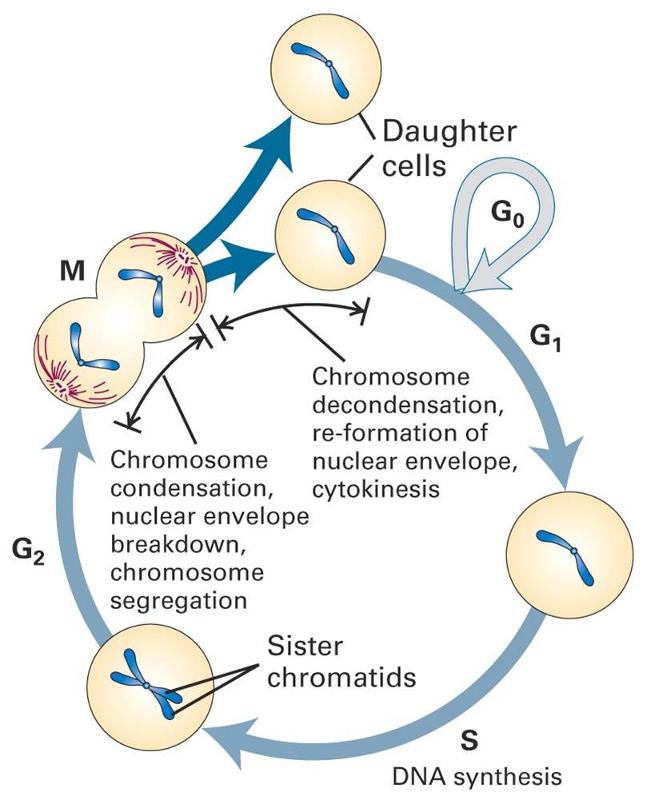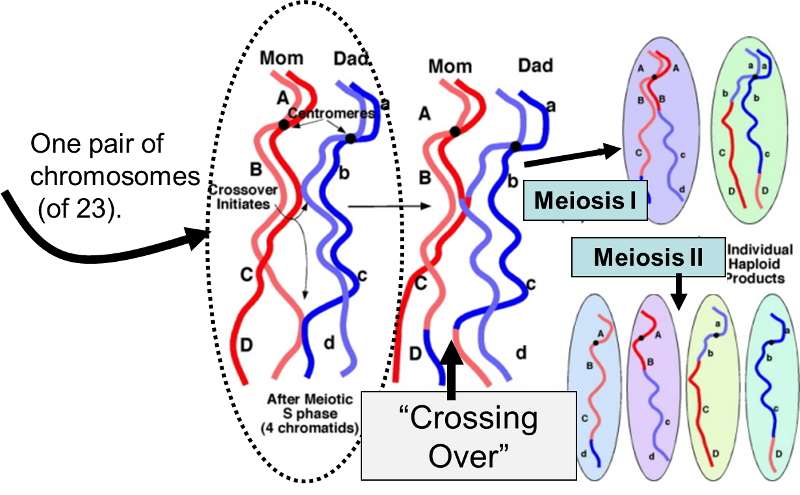Reproduction
Binary Fission in Prokaryotes
Prokaryotes reproduce by the relatively simple process of binary fission. The single chromosome replicates and each copy attaches to a different location on the cell membrane. The cell membrane then begins to invaginate and eventually separates into two genetically identical bacteria. A similar process is used to replicate mitochondria within eukaryotic cells, but the overall process of cell replication in eukaryotes is more complicated (see below).
Mitosis

Adapted from http://www.slideshare.net/SurenderRawat3/cell-cycle-checkpoints-apoptosis-and-cancer
Mitosis is the process by which eukaryotic cells replicate by dividing into two genetically identical cells. It is the process by which new cells are formed in the growing embryo and after birth, and mitosis also replaces cells that have died or been shed. In humans some cells retain the capacity to divide throughout life. These "stem cells" divide by mitosis and produce daughter cells which then differentiate into a particular cell type. This provides a way of replacing cells, such as skin cells; the epithelial cells that line the respiratory, digestive, and urogenital tracts; and blood cells. Benign and malignant tumors also growth through mitosis.
The Cell Cycle
Cells normally follow a carefully controlled cell cycle, depicted below.
Many of our cells are mature functioning cells that are not actively dividing. These are cells in the G0 phase; this is sometimes called the "resting phase," but these cells are actively functioning, and they are resting only in the sense that they aren't replicating. The phases in dividing cells are as follows:
- G1, when the cell grows in size in preparation for division
- S, when synthesis of new DNA (replication) takes place
- G2, when there is continued cell growth
- M, which stands for mitosis, i.e., when the cell actually divides into two identical cells
The cell cycle is normally carefully controlled by a number of biochemical mechanisms. Loss of control mechanisms can result in abnormal cell division and a progression to to tumor formation. This is discussed in greater detail in the online module on cancer.
Meiosis
Meiosis is the specialized process by which gametes (sperm and eggs) are produced for sexual reproduction in the ovaries and testes. Recall that humans have 22 pairs of homologous chromosomes and one pair of sex chromosomes; one member of each pair came from the mother, and the other from the father. The 46 chromosomes are referred to as the diploid (2n) number, because there are two of each. In order for the fertilized egg to end up with the correct diploid number, sperm cells and eggs must be produced such that each has only one chromosome from each pair. In other words, gametes have only 23 chromosomes (referred to as the haploid number (1n). Meiosis, then, is the process by which specialized diploid stem cells in the ovary (oogonia) and testes (spermatogonia) produce eggs and sperm which have a haploid number of chromosomes. Thus, each gamete has 23 chromosomes (one from each of the 22 homologous pairs + 1 sex chromosome).
The video below shows the differences between mitosis and meiosis.
Meiosis Shuffles The Deck
Meiosis produces sperm and eggs with novel mixtures of the original parental chromosomes due to:
- "Random assortment": Separation of homologous pairs of maternal and paternal chromosomes results in each gamete randomly getting some maternal chromosomes and some paternal. Random assortment of 23 pairs of chromosomes can produce > 8 million possible combinations.
- "Crossing over": After maternal and paternal chromosomes match up as homologous pairs, they exchange sections of DNA. This further shuttles the genetic deck.



